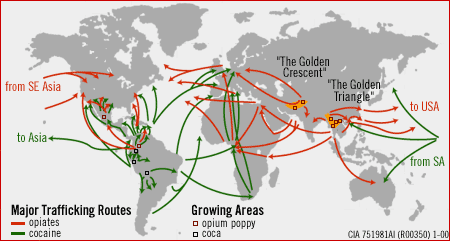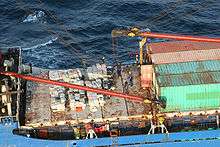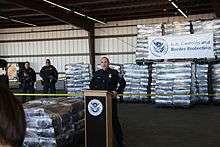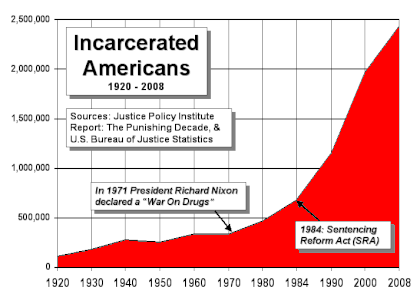Illegal drug trade in the United States
The U.S. Federal Government is an opponent of the illegal drug trade; however, state laws vary greatly and in some cases contradict federal laws. Despite the US government's official position against the drug trade, US government agents and assets have been implicated in the drug trade and were caught and investigated during the Iran-Contra scandal, implicated in the use of the drug trade as a secret source of funding for the USA's support of the Contras. Page 41 of the December 1988 Kerry report to the US Senate[1] states that "indeed senior US policy makers were not immune to the idea that drug money was a perfect solution to the Contra's funding problem."


The Organization of American States estimated that the revenue for cocaine sales in the U.S. was $34 billion in 2013. The Office of National Drug Control Policy estimates that $100 billion worth of illegal drugs were sold in the U.S. in 2013.[2]
Acclaimed investigator and former DEA agent Michael Levine has alleged that the CIA participated in orchestrating the 1980 Cocaine Coup in Bolivia to install an Operation Condor military government, in place of the pre-coup civilian government. The pre-coup government had collaborated with the DEA in bringing leaders of the Roberto Suarez cartel to justice, and Levine alleges that the CIA not only intervened judicially to release the extradited cartel leaders and allow their flight to Bolivia, but also enabled them to collaborate with right-wing military factions in overthrowing the civilian government that had collaborated with the DEA. The drug links of the coup government were obvious to the international community, which led to the coup becoming termed "the Cocaine Coup" by historians. Levine alleges that one of the CIA agents who participated in the coup was Klaus Barbie, the former SS Nazi known as the "Butcher of Lyon," who had previously collaborated with the CIA in Bolivia during the capture and execution of Che Guevara.
Contrary to its official goals, the US has suppressed research on drug usage, although the CIA researched regardless during MKULTRA. For example, in 1995 the World Health Organization (WHO) and the United Nations Interregional Crime and Justice Research Institute (UNICRI) announced in a press release the publication of the results of the largest global study on cocaine use ever undertaken. However, a decision in the World Health Assembly banned the publication of the study. In the sixth meeting of the B committee the US representative threatened that "If WHO activities relating to drugs failed to reinforce proven drug control approaches, funds for the relevant programmes should be curtailed". This led to the decision to discontinue publication. A part of the study has been released.[3] Several government-sponsored reports by commissioned experts have pointed to public substance abuse treatment as opposed to criminalization as the only effective way to battle the public health crisis caused by drugs; these recommendations have been mostly ignored by US government officials, and in some cases suppressed.
War on Drugs


The "War on Drugs" is a term commonly applied to a campaign of prohibition and foreign military aid and military intervention undertaken by the United States government, with the assistance of participating countries, and the stated aim to define and reduce the illegal drug trade. This initiative includes a set of drug policies of the United States that are intended to discourage the production, distribution, and consumption of illegal psychoactive drugs. The term was first used by U.S. President Richard Nixon, and was later popularized by the media.
Minors
The U.S. government's most recent 2005 National Survey on Drug Use and Health (NSDUH) reported that nationwide over 800,000 adolescents ages 12–17 sold illegal drugs during the twelve months preceding the survey.[4] The 2005 Youth Risk Behavior Survey by the U.S. Centers for Disease Control and Prevention (CDC) reported that nationwide 25.4% of students had been offered, sold, or given an illegal drug by someone on school property. The prevalence of having been offered, sold, or given an illegal drug on school property ranged from 15.5% to 38.8% across state CDC surveys (median: 26.1%) and from 20.3% to 40.0% across local surveys (median: 29.4%).[5]
Despite over US$7 billion spent annually towards arresting[6] and prosecuting nearly 800,000 people across the country for marijuana offenses in 2005 (FBI Uniform Crime Reports), the federally funded Monitoring the Future Survey reports about 85% of high school seniors find marijuana “easy to obtain.” That figure has remained virtually unchanged since 1975, never dropping below 82.7% in three decades of national surveys.[7]
In 2009, the Justice Department identified more than 200 U.S. cities in which Mexican drug cartels "maintain drug distribution networks or supply drugs to distributors" - up from 100 three years earlier.[8]
Women
Women are often involved in the illegal drug trade in the United States, typically in marginal, low-level roles.[9]
See also
- Bureau of Alcohol, Tobacco, Firearms, and Explosives (ATF)
- Drug Enforcement Administration (DEA)
- Federal Bureau of Investigation (FBI)
- Immigration and Customs Enforcement (ICE)
- United States Customs and Border Protection (CBP)
References
- "Drugs, Law Enforcement and Foreign Policy" (PDF). 100th Congress, 2d session. December 1988. Retrieved 29 October 2010.
- "The Biggest Organized Crime Groups in the World". Fortune. 2014-09-14.
- WHO/UNICRI (1995). "WHO Cocaine Project".
- "Results from the 2005 National Survey on Drug Use and Health: National Findings". Retrieved 29 October 2010.
- "Youth Risk Behavior Surveillance - United States, 2005". Cdc.gov. Retrieved 2008-10-17.
- "Costs of Marijuana Prohibition: Economic Analysis". Prohibitioncosts.org. Retrieved 2008-10-17.
- "Trends in Availability of Drugs as Perceived by Twelfth Graders" (PDF). Retrieved 29 October 2010.
- "Border violence threatens Americans". The Washington Times. April 1, 2010.
- Maher, L.; Hudson, S. L. (1 October 2007). "Women in the Drug Economy: A Metasynthesis of the Qualitative Literature". Journal of Drug Issues. 37 (4): 805–826. doi:10.1177/002204260703700404.
.svg.png)